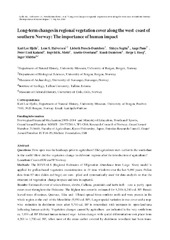| dc.contributor.author | Hjelle, Kari Loe | |
| dc.contributor.author | Halvorsen, Lene Synnøve | |
| dc.contributor.author | Prøsch-Danielsen, Lisbeth | |
| dc.contributor.author | Sugita, Shinya | |
| dc.contributor.author | Paus, Aage | |
| dc.contributor.author | Kaland, Peter Emil | |
| dc.contributor.author | Mehl, Ingvild Kristine | |
| dc.contributor.author | Overland, Anette | |
| dc.contributor.author | Danielsen, Randi | |
| dc.contributor.author | Høeg, Helge Irgens | |
| dc.contributor.author | Midtbø, Inger | |
| dc.date.accessioned | 2019-06-05T10:40:30Z | |
| dc.date.available | 2019-06-05T10:40:30Z | |
| dc.date.issued | 2018-05 | |
| dc.Published | Hjelle KL, Halvorsen LS, Prøsch-Danielsen L, Sugita S, Paus A, Kaland PE, Mehl IKM, Overland A, Danielsen R, Høeg HI, Midtbø I. Long-term changes in regional vegetation cover along the west coast of southern Norway: The importance of human impact. Journal of Vegetation Science. 2018;29(3):404-415 | eng |
| dc.identifier.issn | 1654-1103 | |
| dc.identifier.issn | 1100-9233 | |
| dc.identifier.uri | https://hdl.handle.net/1956/19875 | |
| dc.description.abstract | Questions: How open was the landscape prior to agriculture? Did agriculture start earlier in the south than in the north? How did the vegetation change in different regions after the introduction of agriculture? Location: Coast of SW and W Norway. Methods: The REVEALS (Regional Estimates of VEgetation Abundance from Large Sites) model is applied for pollen‐based vegetation reconstruction in 19 time windows over the last 9,000 years. Pollen data from 63 sites (lakes and bogs) are compiled and systematically used for data analysis so that the structure of vegetation change in space and time is captured. Results: Estimated cover of selected trees, shrubs, Calluna, graminids and herbs indicate a partly open outer coast throughout the Holocene. The highest tree cover is estimated for 8,200–6,200 cal. BP. Broad‐leaved trees (Fraxinus, Quercus, Tilia and Ulmus) spread from south to north and were present in the whole region at the end of the Mesolithic (5,950 cal. BP). Larger spatial variation in tree cover and a step‐wise reduction in deciduous trees after 5,700 cal. BP is concordant with increases in open‐land taxa indicating human activity. Vegetation changes caused by agriculture are indicated in the very south from ca. 5,950 cal. BP. Distinct human‐induced vegetation changes with spatial differentiation took place from 4,200 to 1,700 cal. BP, when most of the areas earlier covered by deciduous woodland had been transformed to cultivated fields, grasslands and heathlands. Increased Poaceae cover from 1,700 cal. BP probably reflects the expansion of mown meadows in addition to pastures. Conclusions: Capturing continuous changes of vegetation structure in space and time elucidates open areas along the western coast prior to the introduction of agriculture. Agriculture started earliest in the very south and spread rapidly along the whole coast prior to the Late Neolithic. Differences within the study area have existed in all time periods, reflecting different land‐use practices adapted to different natural conditions. | en_US |
| dc.language.iso | eng | eng |
| dc.publisher | Wiley | eng |
| dc.subject | anthropogenic impact | eng |
| dc.subject | cultivated fields | eng |
| dc.subject | forest cover | eng |
| dc.subject | grasslands | eng |
| dc.subject | heathlands | eng |
| dc.subject | Holocene | eng |
| dc.subject | long-term vegetation changes | eng |
| dc.subject | palaeoecology | eng |
| dc.subject | pollen analysis | eng |
| dc.subject | REVEALS model | eng |
| dc.title | Long-term changes in regional vegetation cover along the west coast of southern Norway: The importance of human impact | eng |
| dc.type | Peer reviewed | en_US |
| dc.type | Journal article | en_US |
| dc.date.updated | 2019-03-19T09:08:04Z | |
| dc.description.version | publishedVersion | |
| dc.rights.holder | Copyright 2018 International Association for Vegetation Science | eng |
| dc.identifier.doi | https://doi.org/10.1111/jvs.12626 | |
| dc.identifier.cristin | 1605661 | |
| dc.source.journal | Journal of Vegetation Science | |
